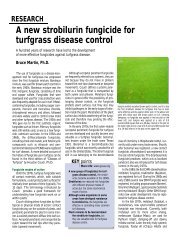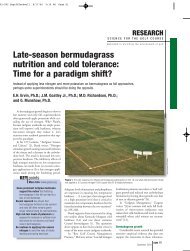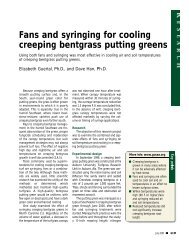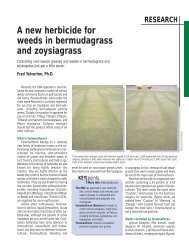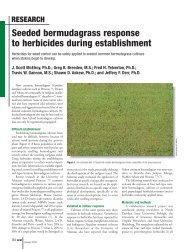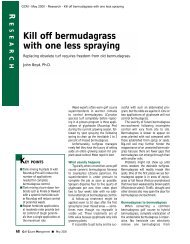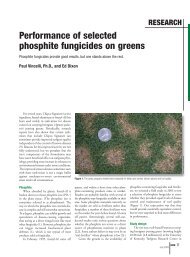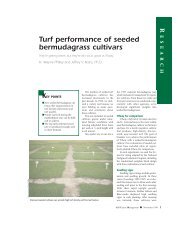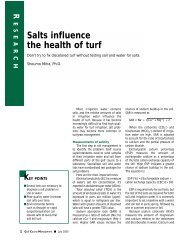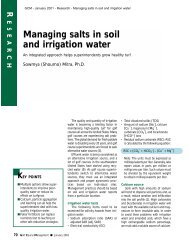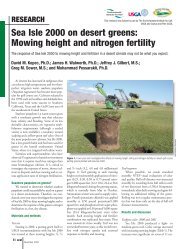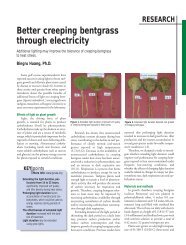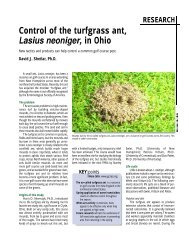Surface organic matter in bermudagrass greens: A primary ... - GCSAA
Surface organic matter in bermudagrass greens: A primary ... - GCSAA
Surface organic matter in bermudagrass greens: A primary ... - GCSAA
Create successful ePaper yourself
Turn your PDF publications into a flip-book with our unique Google optimized e-Paper software.
RESEARCH<strong>Surface</strong> <strong>organic</strong> <strong>matter</strong><strong>in</strong> <strong>bermudagrass</strong> <strong>greens</strong>:A <strong>primary</strong> stress?Excessive <strong>organic</strong> <strong>matter</strong> can deprive <strong>bermudagrass</strong> <strong>greens</strong> of oxygen and nutrients.Robert N. Carrow, Ph.D.In the preced<strong>in</strong>g article, “<strong>Surface</strong> <strong>organic</strong><strong>matter</strong> <strong>in</strong> creep<strong>in</strong>g bentgrass <strong>greens</strong>,” I discuss<strong>primary</strong> and secondary problems associatedwith <strong>organic</strong> <strong>matter</strong> dynamics <strong>in</strong> the surfacesoil zone (0-2 <strong>in</strong>ches [5.1 centimeters]) ofcreep<strong>in</strong>g bentgrass putt<strong>in</strong>g <strong>greens</strong> andresearch on manag<strong>in</strong>g these stresses (1). Manyof the creep<strong>in</strong>g bentgrass and <strong>bermudagrass</strong>cultivars used on putt<strong>in</strong>g <strong>greens</strong> have a strongtendency to accumulate <strong>organic</strong> <strong>matter</strong>with<strong>in</strong> the surface zone (1,3,6). The preced<strong>in</strong>garticle also presents an overview of pastand current research related to the <strong>in</strong>fluenceof <strong>organic</strong> <strong>matter</strong> content on soil physicalproperties of putt<strong>in</strong>g <strong>greens</strong> constructedwith a high-sand-content root zone (hereafterreferred to as “high-sand <strong>greens</strong>”).HypothesisThe hypothesis I present here is thatadverse soil physical conditions triggered byexcessive <strong>organic</strong> <strong>matter</strong> accumulation <strong>in</strong> ultradwarf<strong>bermudagrass</strong> <strong>greens</strong> are usually the<strong>primary</strong> stresses that lead to many of the problemsobserved on these <strong>greens</strong>. Examples ofthese problems are root-rot organisms (forexample, Gaeumannomyces species, which cause<strong>bermudagrass</strong> decl<strong>in</strong>e) (Figure 1); Curvulariaspecies; root rot; limited root<strong>in</strong>g depth and associatedirrigation and fertilization challenges, etc.The dist<strong>in</strong>ction between <strong>primary</strong> stressesand secondary stresses or symptoms is veryimportant for the development of successfulmanagement protocols. A <strong>primary</strong> stress is acondition that causes direct physiological orpest stress on a plant, but it also creates conditionsfavorable for the occurrence of othersecondary stresses. Symptoms or secondarystresses are often the problems that are seenby super<strong>in</strong>tendents and golfers. In turfgrassmanagement, secondary stresses must bedealt with when they occur, but to preventfrequent reoccurrence, the long-term ma<strong>in</strong>-tenance goal should be elim<strong>in</strong>ation of the <strong>primary</strong>stresses or underly<strong>in</strong>g causes.Other scientists or super<strong>in</strong>tendents maynot agree about which stresses are <strong>primary</strong>and which are secondary for <strong>bermudagrass</strong><strong>greens</strong>, but I hope to stimulate dialogue andresearch directed to these issues. The mostconstructive dialogue takes place when analternative hypothesis is presented thatexpla<strong>in</strong>s the observed responses.Organic <strong>matter</strong> dynamicsThe first problemIn the preced<strong>in</strong>g article, I noted two typesof <strong>organic</strong> <strong>matter</strong> problems on creep<strong>in</strong>g bentgrass<strong>greens</strong> (1,5). One problem occurredwhen direct high-temperature stress causedrapid deterioration of creep<strong>in</strong>g bentgrass surfaceroots and changed the nature of the<strong>organic</strong> <strong>matter</strong> from live roots with a structureto gelat<strong>in</strong>ous dead tissue. When liveroots are present, higher <strong>organic</strong> <strong>matter</strong> contentmay be present without caus<strong>in</strong>g adversesoil physical responses, such as low aerationKEY po<strong>in</strong>tsMore Info: www.gcsaa.orgExcessive <strong>organic</strong> <strong>matter</strong> accumulationis a <strong>primary</strong> stress on <strong>bermudagrass</strong><strong>greens</strong> that can lead to secondarystresses.Secondary stresses <strong>in</strong>clude: excessivemoisture retention, low oxygenlevels, reduced water <strong>in</strong>filtration anddecreased gas exchange.Aggressive topdress<strong>in</strong>g along withhollow-t<strong>in</strong>e aeration helps prevent<strong>organic</strong> <strong>matter</strong> buildup.Manag<strong>in</strong>g the <strong>primary</strong> stress canreduce secondary stresses.or low water <strong>in</strong>filtration. After the roots havedied over a period of a few days, the gelat<strong>in</strong>ousdead tissues can rapidly seal the surface.Because <strong>bermudagrass</strong>es have superiorhigh-temperature tolerance, high temperatureswould not be expected to kill <strong>bermudagrass</strong>roots. However, the cool-season grass used <strong>in</strong>overseed<strong>in</strong>g <strong>bermudagrass</strong> <strong>greens</strong> could sufferthis <strong>in</strong>jury <strong>in</strong> late spr<strong>in</strong>g. In that situation, the<strong>bermudagrass</strong> green would exhibit low <strong>in</strong>filtrationand a soggy surface for a period of timeuntil the microorganisms break down the fresh<strong>organic</strong> <strong>matter</strong>. Dur<strong>in</strong>g this period of low oxygen,some <strong>bermudagrass</strong> root damage couldoccur. Salt or other stresses could also causerapid death of overseeded grasses on occasionand <strong>in</strong>duce temporary low-oxygen levels.The second problemThe second <strong>organic</strong> <strong>matter</strong> problem,excessive accumulation of <strong>organic</strong> <strong>matter</strong>, ismore likely to be serious on <strong>bermudagrass</strong><strong>greens</strong> and sometimes fairways and tees. Forall grass species, <strong>organic</strong> <strong>matter</strong> levels greaterthan 4-5% (by weight) favor adverse soilphysical responses. At these levels, the numberof larger macropores (aeration porosity,dra<strong>in</strong>age porosity) rapidly starts to decl<strong>in</strong>e,and moisture retention <strong>in</strong>creases at theexpense of aeration with<strong>in</strong> the 0-2-<strong>in</strong>ch surfacezone (1,5). With fewer macropores, water<strong>in</strong>filtration and oxygen diffusion decl<strong>in</strong>eacross the zone. Thus, common themes areassociated with excessive <strong>organic</strong> <strong>matter</strong> <strong>in</strong> thesurface zone of both creep<strong>in</strong>g bentgrass and<strong>bermudagrass</strong> <strong>greens</strong> with high sand content(1,5):• excess moisture retention• low aeration (oxygen) with<strong>in</strong> the zone• reduced water <strong>in</strong>filtration• decreased gas exchange across the zoneunless cultivation creates temporarymacropore channels for water/air flow102 GCMMay 2004
RESEARCHPrimary stressesI propose that <strong>organic</strong> <strong>matter</strong> accumulationand associated adverse soil physicalresponses are the <strong>primary</strong> stresses on ultradwarf<strong>bermudagrass</strong>es, because <strong>in</strong> most<strong>in</strong>stances they occur before other commonlyreported stresses are observed. As with creep<strong>in</strong>gbentgrass, subsurface layers of f<strong>in</strong>es, surfacecompaction or a push-up green with toomany f<strong>in</strong>es can create the same high-moistureand low-oxygen conditions caused by excessive<strong>organic</strong> <strong>matter</strong>. However, on high-sandgreen mixes, these conditions are most oftencaused by too much <strong>organic</strong> <strong>matter</strong>. Push-up<strong>bermudagrass</strong> <strong>greens</strong> frequently conta<strong>in</strong>more clay and silt than high-sand <strong>greens</strong>, butvigorous topdress<strong>in</strong>g often creates a sand cap,which can exhibit surface <strong>organic</strong> <strong>matter</strong>accumulation just as a high-sand green does.Conditions favor<strong>in</strong>g <strong>organic</strong> <strong>matter</strong>On <strong>bermudagrass</strong> <strong>greens</strong>, <strong>organic</strong> <strong>matter</strong>accumulation seems to be associated with oneor more of the conditions discussed below.Grass typeUltradwarf <strong>bermudagrass</strong> cultivars have atendency to accumulate <strong>organic</strong> <strong>matter</strong>with<strong>in</strong> the surface zone (Figure 2). The densesurface and very close mow<strong>in</strong>g heights usedon these grasses also make <strong>in</strong>corporation oftopdress<strong>in</strong>g difficult. Seashore paspalum on<strong>greens</strong> is less prone to develop<strong>in</strong>g excessivesurface <strong>organic</strong> <strong>matter</strong> than the ultradwarf<strong>bermudagrass</strong>es if it is ma<strong>in</strong>ta<strong>in</strong>ed accord<strong>in</strong>gto paspalum requirements and not as a<strong>bermudagrass</strong> (2). For seashore paspalum,reduc<strong>in</strong>g nitrogen rates and irrigat<strong>in</strong>g on adeeper and less frequent basis are effective <strong>in</strong>prevent<strong>in</strong>g excessive <strong>organic</strong> <strong>matter</strong>.Anaerobic conditionsWhenever oxygen with<strong>in</strong> the 0-2-<strong>in</strong>ch (0-5.1-centimeter) zone is limited enough to createanaerobic conditions, decomposition of<strong>organic</strong> <strong>matter</strong> greatly decl<strong>in</strong>es because microbialactivity slows. Thus, when <strong>organic</strong> <strong>matter</strong>accumulation is sufficient to limit aerationwith<strong>in</strong> this zone, reduced microbial activitywill probably cause even more accumulation.Prolonged wet weather or daily irrigation isespecially conducive to enhanc<strong>in</strong>g <strong>organic</strong><strong>matter</strong> buildup because the moist conditionsma<strong>in</strong>ta<strong>in</strong> a consistently anaerobic status.On a high-sand green, soil oxygen may beadequate for deeper roots below the zone ifcultivation operations have created sufficientFigure 1. Th<strong>in</strong>n<strong>in</strong>g associated with <strong>bermudagrass</strong> decl<strong>in</strong>e of Cynodon species turf (Repr<strong>in</strong>ted from Compendium ofTurfgrass Diseases, 2nd ed., APS Press, 1992).macropores to allow oxygen diffusion acrossthe surface zone. However, with<strong>in</strong> the surfacezone, conditions are more anaerobic.Anaerobic conditions at the surface often stimulategrasses to produce adventitious or surfaceroots, which add to the surface <strong>organic</strong> <strong>matter</strong>biomass. Poor <strong>in</strong>ternal dra<strong>in</strong>age deeper with<strong>in</strong>the soil profile would cause a waterlogged conditionat the surface and foster <strong>organic</strong> <strong>matter</strong>accumulation dur<strong>in</strong>g wet weather.Acidic conditionsAn acidic condition <strong>in</strong> the first <strong>in</strong>ch (2.5centimeters) of the soil surface can occur onacid sands <strong>in</strong> humid regions, when acidic nitrogenfertilizers are used or when rout<strong>in</strong>e wateracidification is practiced. When soil is sampledat 3 to 4 <strong>in</strong>ches (7.6-10.2 centimeters), low pHat the surface may not be apparent. Soil pHbelow 5.5 greatly restricts the growth of bacterialpopulations that are important <strong>in</strong>decompos<strong>in</strong>g more-resistant <strong>organic</strong> <strong>matter</strong>.Poor air dra<strong>in</strong>age or humid weatherWhen the surface zone does not rapidlydry after irrigation or ra<strong>in</strong>, longer periods ofanaerobic conditions are favored (Figure 3).Secondary problems or symptomsDiverse secondary problems or symptomsarise <strong>in</strong> response to the adverse soil physicalconditions created by excessive <strong>organic</strong> <strong>matter</strong>,and several can occur at one time. Oftena green fails because of multiple <strong>primary</strong> andsecondary problems rather than a s<strong>in</strong>glecause. Common secondary problems <strong>in</strong>cludethe follow<strong>in</strong>g (3,6).Limited root<strong>in</strong>g depthA tendency for reduced root<strong>in</strong>g depthwith<strong>in</strong> one to two years after establishmenthas been commonly observed on <strong>bermudagrass</strong><strong>greens</strong> with high sand content, eventhough <strong>bermudagrass</strong>es have the geneticcapability to be deep rooted. Limited rootdepth may be a result of one or more factors.Organic <strong>matter</strong> can limit oxygen diffusionacross the surface zone <strong>in</strong>to the deeper rootmedia, especially <strong>in</strong> wet weather. Rootsrequire oxygen 24 hours a day, and oxygendemand by the plant and microorganisms canbe high <strong>in</strong> summer. Without adequate oxygen,root growth rate decl<strong>in</strong>es, and undersevere oxygen stress, roots may die back.Creat<strong>in</strong>g temporary macropores by cultivationoperations across this zone can helpma<strong>in</strong>ta<strong>in</strong> better oxygen diffusion. Integrat<strong>in</strong>gsufficient topdress<strong>in</strong>g sand <strong>in</strong>to the zone canenhance water and air flow.Limited oxygen with<strong>in</strong> the zone stressesroots and may cause root prun<strong>in</strong>g. This obviously<strong>in</strong>fluences deeper roots.May 2004GCM 103
RESEARCHFigure 2. Ultradwarf <strong>bermudagrass</strong> <strong>greens</strong> show evidenceof excessive <strong>organic</strong> <strong>matter</strong> <strong>in</strong> the top 2 <strong>in</strong>ches ofsoil two years after establishment.Prolonged cloudy weather and close mow<strong>in</strong>gmay contribute to root decl<strong>in</strong>e by provid<strong>in</strong>gless favorable conditions for produc<strong>in</strong>g theplant carbohydrates (food) necessary to ma<strong>in</strong>ta<strong>in</strong>current roots or generate new ones (3).Root and crown tissue <strong>in</strong>juryAll liv<strong>in</strong>g tissues with<strong>in</strong> the surface 2<strong>in</strong>ches (5.1 centimeters) must have adequateoxygen to ma<strong>in</strong>ta<strong>in</strong> viability. Prolongedexposure to low oxygen can cause root andlower crown <strong>in</strong>jury, mak<strong>in</strong>g these tissues lessviable and more susceptible to root pathogensand drought stress if they occur. Thus, lack ofoxygen and not just root-rot organisms maycause root rot or lower crown rot.Inhibition of nutrient and water uptakeThe comb<strong>in</strong>ation of restricted root<strong>in</strong>gdepth and <strong>in</strong>jury to root or crown tissue<strong>in</strong>hibits nutrient and water uptake. Whenexposed to low-oxygen conditions, even relativelyhealthy roots are less efficient at nutrientand water uptake. When roots become so limitedthat frequent irrigation becomes necessary,the surface zone then rema<strong>in</strong>s moist most ofthe time, which promotes low oxygen and limitedroot<strong>in</strong>g conditions. Although cationexchange capacity (CEC) tends to be adequatefor nutrient retention with<strong>in</strong> 2-4 centimoles/kilogram,most of the CEC resideswith<strong>in</strong> the surface 0-2 <strong>in</strong>ches (0-5.1 centimeters)<strong>in</strong> the <strong>organic</strong> <strong>matter</strong>. When roots areshallow, fertilization is a challenge. Dur<strong>in</strong>gdrier periods, frequent irrigation is required toavoid drought stress. With a limited root systemand roots that may not be very healthy,spoon-feed<strong>in</strong>g all nutrients is necessary.Bermudagrass decl<strong>in</strong>e and root rotRoot rot associated with Gaeumannomycesspecies is probably the most recognized root-rot104 GCM May 2004Photos courtesy of P. O’Brien and C. Hartwiger<strong>in</strong>jury, but other causes may be anthracnosebasal rot, Helm<strong>in</strong>thosporium species and Pythiumspecies. Prolonged periods of ra<strong>in</strong>y weather willtrigger root-rot activity. The comb<strong>in</strong>ation of prolongedcloudy and wet weather is especially conduciveto root rot development: Cloudy weathercan place carbohydrate stress on roots while foster<strong>in</strong>ga moist surface, which favors the diseaseorganism and low-oxygen stress on the root andlower crown tissues (3). A high-sand surface conditionwould allow excess water to dra<strong>in</strong>, the surfaceto dry, and oxygen with<strong>in</strong> the surface to beadequate.The important issue is whether thesuper<strong>in</strong>tendent approaches the problembeliev<strong>in</strong>g the <strong>primary</strong> problem is a rootpathogen or excessive <strong>organic</strong> <strong>matter</strong> that createsconditions conducive to root rot. Whenroot-rot organisms are active, it is importantto focus on treat<strong>in</strong>g the disease, but, <strong>in</strong> thelonger term, controll<strong>in</strong>g the <strong>organic</strong> <strong>matter</strong>may be the way to reduce the frequency ofthe problem and fungicide treatments.In my experience, the <strong>organic</strong> <strong>matter</strong> zoneis very effective <strong>in</strong> screen<strong>in</strong>g the fungicidefrom the organisms below the surface zone or<strong>in</strong> the lower region of the zone. Thus, super<strong>in</strong>tendentsmay wish to consider a solid t<strong>in</strong>eoperation ( 1 ⁄4 <strong>in</strong>ch [6.4 millimeters] <strong>in</strong> diameter)or a HydroJect operation just beforefungicide application to allow the fungicide topenetrate though the zone.Other secondary problemsOther secondary problems <strong>in</strong>clude thefollow<strong>in</strong>g.• Algae.• Soft, soggy surfaces. If water <strong>in</strong>filtrationdecl<strong>in</strong>es too much, the surface may rema<strong>in</strong>too soggy or waterlogged and prone to track<strong>in</strong>gfrom vehicles.• Greater potential for <strong>in</strong>tracellular freez<strong>in</strong>gdamage dur<strong>in</strong>g wet periods of late w<strong>in</strong>terand early spr<strong>in</strong>g may occur <strong>in</strong> the morenorthern areas of <strong>bermudagrass</strong> adaptation.• Excessive dry<strong>in</strong>g, desiccation and extra-cellularfreez<strong>in</strong>g of tissues <strong>in</strong> the upper surface ofthe high-<strong>organic</strong>-<strong>matter</strong> zone may <strong>in</strong>crease <strong>in</strong>regions with cold w<strong>in</strong>ters without snow cover.• Light frequent irrigation with sal<strong>in</strong>e watercan lead to salt accumulation <strong>in</strong> the <strong>organic</strong><strong>matter</strong> zone and root stress.ManagementThe <strong>primary</strong> reason for this article was toexpla<strong>in</strong> the adverse effects of excessive <strong>organic</strong><strong>matter</strong> <strong>in</strong> the surface zone <strong>in</strong> the context ofproblems observed on <strong>bermudagrass</strong> <strong>greens</strong>. Itis important for super<strong>in</strong>tendents to determ<strong>in</strong>ewhether a problem is a secondary problem orsymptom, or whether it is the result of excessive<strong>organic</strong> <strong>matter</strong> <strong>in</strong> the surface.Proper identification of the <strong>primary</strong> orunderly<strong>in</strong>g problems allows super<strong>in</strong>tendentsto focus on prevent<strong>in</strong>g future problems withless emphasis on crisis management. It isimportant to note, however, that environmentalconditions alone may cause a diseasethat is usually associated with excessive<strong>organic</strong> <strong>matter</strong>, even though excessive <strong>organic</strong><strong>matter</strong> is not present. In such a case, the diseasewould be considered a <strong>primary</strong> problem.Should all <strong>organic</strong> <strong>matter</strong> be removed?As previously noted, <strong>organic</strong> <strong>matter</strong> contentof more than 4-5% (by weight) favorslow aeration and low water <strong>in</strong>filtration. Doesthis mean that all <strong>organic</strong> <strong>matter</strong> should beremoved from putt<strong>in</strong>g <strong>greens</strong>? No!Along the Gulf coast from Florida toLouisiana, golf courses that exhibited very little<strong>organic</strong> <strong>matter</strong> accumulation still had1.5% <strong>organic</strong> <strong>matter</strong> content <strong>in</strong> the 0-2 <strong>in</strong>ch (0-5.1 centimeter) surface zone, and this <strong>organic</strong><strong>matter</strong> was live turf. Liv<strong>in</strong>g and dead <strong>organic</strong><strong>matter</strong> are very difficult to separate, but a backgroundlevel of 1.5% is reasonable. Thesecourses also had very low (
RESEARCHgram) CEC because little dead <strong>organic</strong> <strong>matter</strong>was present at CEC sites and essentially no claywas found. Thus, some <strong>organic</strong> <strong>matter</strong>enhances CEC status.Thatch or mat?Is the surface zone of high <strong>organic</strong> <strong>matter</strong>thatch or mat? Thatch is a zone of deadand liv<strong>in</strong>g <strong>organic</strong> <strong>matter</strong> without appreciablesand <strong>in</strong>tegrated <strong>in</strong>to it. Sometimes athatch zone created dur<strong>in</strong>g grow-<strong>in</strong> becomesburied and rema<strong>in</strong>s as a thatch layer problem.Mat is an <strong>organic</strong> zone that has considerablesand <strong>in</strong>tegrated with<strong>in</strong> it, with sand as thedom<strong>in</strong>ant matrix.From field observations, it appears that thequantity of sand topdress<strong>in</strong>g sufficient to ma<strong>in</strong>ta<strong>in</strong>a uniform, stable surface with goodputt<strong>in</strong>g speed is often less than the quantity oftopdress<strong>in</strong>g required to create a true mat. Thesurface zone of many <strong>greens</strong> appears to be a“near mat,” but with <strong>in</strong>sufficient sand to negatethe <strong>organic</strong> <strong>matter</strong>. When sand is not ma<strong>in</strong>ta<strong>in</strong>edas the <strong>primary</strong> matrix, the result is considerablesand float<strong>in</strong>g <strong>in</strong> the <strong>organic</strong> <strong>matter</strong>. Inthat case, the <strong>organic</strong> <strong>matter</strong>, not the sand, controlsthe aeration and moisture status.Management practices<strong>Surface</strong> <strong>organic</strong> <strong>matter</strong> accumulation ismanaged by a comb<strong>in</strong>ation of the follow<strong>in</strong>gpractices.Dilution. Dilution of the surface <strong>organic</strong><strong>matter</strong> through aggressive topdress<strong>in</strong>g, especially<strong>in</strong> comb<strong>in</strong>ation with hollow-t<strong>in</strong>e aerationand vent<strong>in</strong>g operations, is the backboneof any successful program. A recent article (5)provides excellent options and guidel<strong>in</strong>es thatare appropriate for <strong>bermudagrass</strong> and creep<strong>in</strong>gbentgrass <strong>greens</strong>. The suggested targetrange for annual topdress<strong>in</strong>g on many sites,40-50 cubic feet/1,000 square feet (121.9-152.4 cubic meters/hectare), is based on historicalrates that were used until a few yearsago when ultralight but more frequentapplications became the norm and resulted<strong>in</strong> less total sand applied.Us<strong>in</strong>g adequate hollow-t<strong>in</strong>e core aerationoperations and vent<strong>in</strong>g operations to ma<strong>in</strong>ta<strong>in</strong>macropores across the surface <strong>organic</strong> <strong>matter</strong>zone at all times is important for ensur<strong>in</strong>goxygen diffusion across the zone to reachunderly<strong>in</strong>g roots. Develop<strong>in</strong>g and ma<strong>in</strong>ta<strong>in</strong><strong>in</strong>gdeeper roots allows less-frequent irrigationso that the surface zone has the opportunityto dry somewhat, which greatly improves oxygenstatus with<strong>in</strong> the zone. If topdress<strong>in</strong>g andFigure 3. Greens with poor air circulation and dra<strong>in</strong>age often exhibit excessive <strong>organic</strong> <strong>matter</strong> <strong>in</strong> the surface layer.Excessive <strong>organic</strong> <strong>matter</strong> <strong>in</strong>duces high moisture and lower oxygen content <strong>in</strong> the root zone, <strong>in</strong>hibit<strong>in</strong>g microbial decompositionof the <strong>organic</strong> <strong>matter</strong>.cultivation operations are <strong>in</strong>sufficient to controlthe surface <strong>organic</strong> <strong>matter</strong> zone quickly,the result will be shallow roots, which requirelight, frequent irrigation and frequent spoonfeed<strong>in</strong>g.This situation fosters even more<strong>organic</strong> <strong>matter</strong> accumulation.<strong>Surface</strong> pH levels. The surface pH shouldbe higher than 5.5 to allow adequate bacterialpopulations for <strong>organic</strong> <strong>matter</strong> decomposition.One practice that has beenrecommended for <strong>bermudagrass</strong> decl<strong>in</strong>e hasbeen the use of acidify<strong>in</strong>g fertilizers. Oneresponse that occurs on soils with at leastsome clay is that at pH below 5.5, more solublemanganese is often observed. However,on sands with CEC from primarily <strong>organic</strong><strong>matter</strong>, this is not the case. Adequate manganeseis important for suppress<strong>in</strong>g take-allpatch (3,4). If the surface pH is below 5.5,the reason for a low pH should be determ<strong>in</strong>ed.Water acidification can cause a lowpH at the surface while also add<strong>in</strong>g appreciablesoluble sulfur. If anaerobic conditionsstart with<strong>in</strong> or below the surface <strong>organic</strong> <strong>matter</strong>zone, the presence of soluble sulfur willgreatly <strong>in</strong>crease the chance for black layer (6).Take-all. On sites with an exist<strong>in</strong>g <strong>organic</strong><strong>matter</strong> problem and a history of take-all, itmay be worthwhile to test not only foliar applicationsof manganese, but also some granularapplications to achieve higher manganese levelswith<strong>in</strong> both the plant and <strong>organic</strong> zone.Secondary stresses. If excessive <strong>organic</strong><strong>matter</strong> stimulates a particular secondarystress, then practices to control the secondarystress will be of immediate concern.Photo courtesy of R.N. CarrowSummaryIn summary, the new ultradwarf <strong>bermudagrass</strong>esused on putt<strong>in</strong>g <strong>greens</strong> have a strongtendency to accumulate <strong>organic</strong> <strong>matter</strong> with<strong>in</strong>the surface zone, and certa<strong>in</strong> stresses are frequentlyobserved on these grasses (decreasedroot<strong>in</strong>g over time, root-rot pathogens, others).The challenge for the super<strong>in</strong>tendent is toidentify the <strong>primary</strong> or underly<strong>in</strong>g stresses andmanage them aggressively.References1. Carrow, R.N. 2004. <strong>Surface</strong> <strong>organic</strong> <strong>matter</strong> <strong>in</strong> bentgrass<strong>greens</strong>. Golf Course Management 72(5):96-101.2. Duncan, R.R., and R.N. Carrow. 2000. Seashorepaspalum: The environmental turfgrass. Wiley,Hoboken, N.J.3. Elliot, M. 2001. Got root rot? Don’t panic. Florida TurfDigest March/April 20-23.4. Heckman, J.R., B.B. Clark and J.A. Murphy. 2003.Optimiz<strong>in</strong>g manganese fertilization for the suppressionof take-all patch disease on creep<strong>in</strong>g bentgrass.Crop Science 43:1395-1398.5. O’Brien, P., and C. Hartwiger. 2003. Aeration andtopdress<strong>in</strong>g for the 21st century. USGA GreenSection Record 41(2):1-7.6. Unruh, J.B., and S. Davis. 2001. Diseases and heatbesiege ultradwarf <strong>bermudagrass</strong>es. Golf CourseManagement 69(4):49-54.Robert N. Carrow, Ph.D. (rcarrow@griff<strong>in</strong>.uga.edu), is aprofessor of turfgrass science and a research scientistat the Georgia Experiment Station, University of Georgia,Griff<strong>in</strong>. Carrow was an <strong>in</strong>structor at <strong>GCSAA</strong> educationsem<strong>in</strong>ars <strong>in</strong> San Diego, and he is one of the subject<strong>matter</strong> experts for <strong>GCSAA</strong>’s onl<strong>in</strong>e W.A.T.E.R. course.May 2004GCM 105



